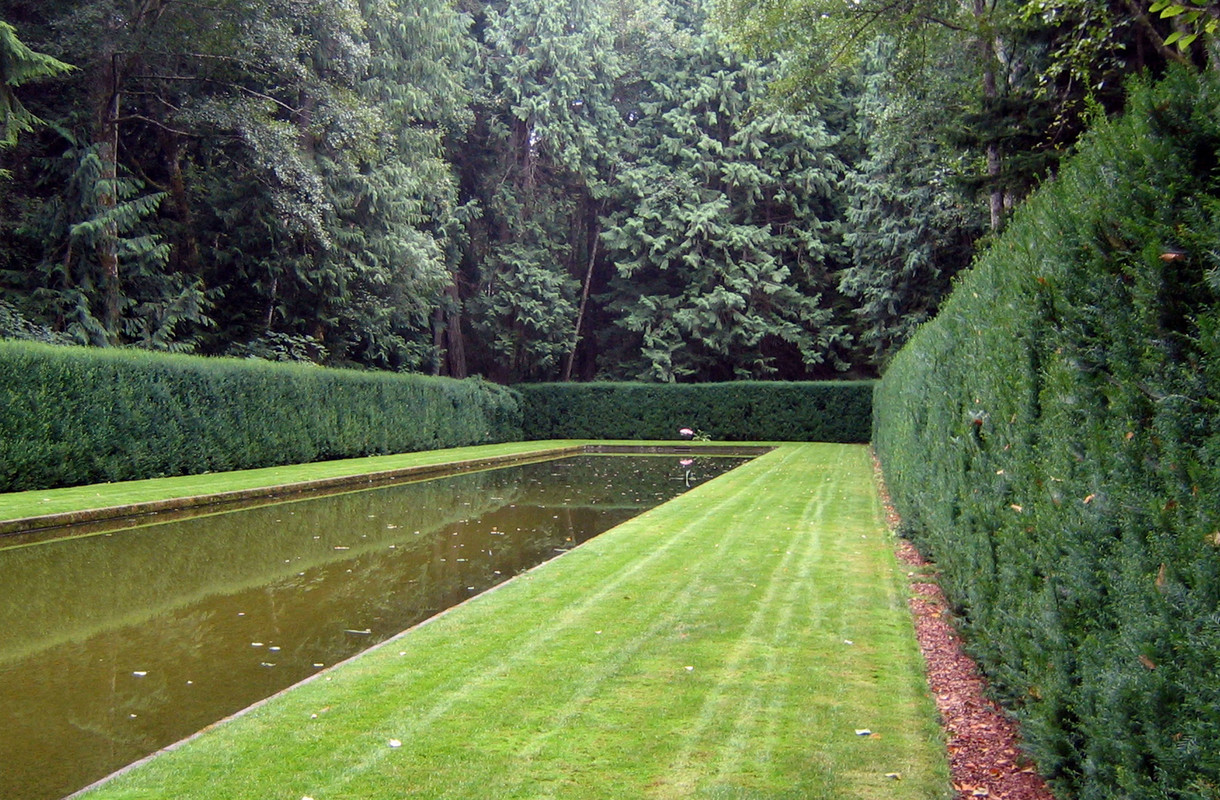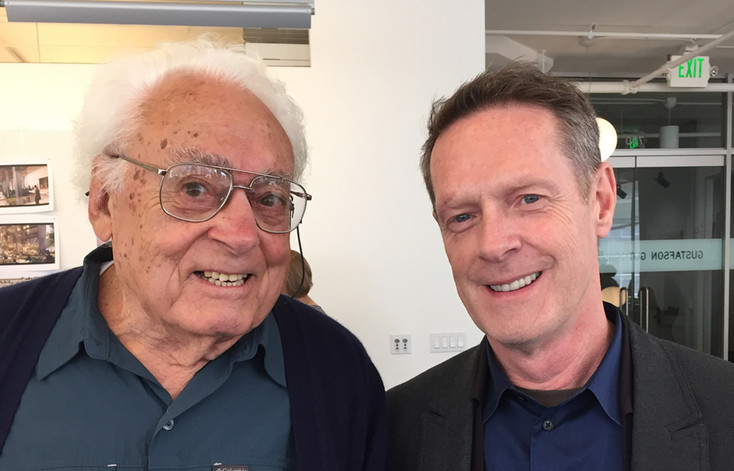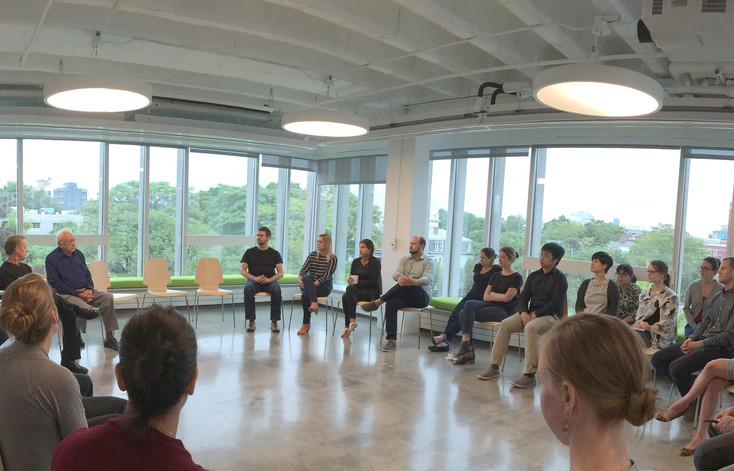A Teacher’s Teacher

Excerpted from Richard Haag: Bloedel Reserve and Gas Works Park, edited by William Saunders for Princeton Architectural Press, Gary Hilderbrand remembers a master of American landscape architecture.
Richard Haag’s Bloedel Reserve and Gas Works Park share an extraordinary power of evocation. Wandering around Bloedel’s moss garden, you feel separated from your own place and time, drenched in green earth, surrounded by primordial ground. Bloedel is ostensibly nature, but in reality a construction, a revelation of nature’s—and our own—reconstructive force, mending the earth after the wound of deforestation.
At Gas Works Park, another kind of ruin was brought to life. Gas Works is a testament to Haag’s commitment to place; he spent years in soils testing, experimenting, testifying, and persuading, eventually giving new meaning to a great mechanical graveyard and forging a new kind of urban pleasure-ground.
How is it that Haag can build projects so diverse and original? How can he avoid dependence on traditions of form or the public’s desires for the conventional and familiar? If his works defy the usual art historical comparative analyses, then how can we hope to understand his motivations and teaching?
Rich Haag’s hold on students is legendary. A distinguished group of former Haag students from the late 1950s and early 1960s at the University of Washington, where he founded an undergraduate program in landscape architecture, has long attributed their affiliation with landscape to Haag. Although they were architecture students and took Haag’s courses as a distraction, they all, after studying with Haag, turned toward the landscape. After some formative years in Haag’s studios and office, Philadelphia landscape architects and University of Pennsylvania teachers Robert Hanna and Laurie Olin have built many acclaimed landscapes, both together and with their separate firms. Likewise, former students Ilze Jones and Grant Jones have built an international practice on their insistence that every project begin as in inquiry into biophysical process, cultural history, and emotional response to place. Frank James, for many years a principal actor in international projects with Sasaki Associates and other firms, built a reputation based on his own Haag-like intensity, fascination with Eastern cultures, beguiling illustrative abilities, and infectious teaching energy. All these practitioners have affected large numbers of students themselves. Haag is a teacher’s teacher.
Haag led these and other students to see the possibilities for having a dramatic impact on and rescuing or protecting the land, as well as the potential for exploring the subjective, connotative aspects of landscape design. While architecture was during this period often constrained by the repetitive demands of program and type and the norms of building in the late-modern idiom, landscape architecture, as taught by Haag, offered fresh circumstances. Change can come about by altering or adjusting the existing condition—editing, removing, managing, or gently shaping. Haag taught that time itself works just as powerfully to change the landscape. He contended that the individual’s primary role in the landscape is to understand nature’s work and disposition; the biological regime and its cosmological order can only be respected. If that meant conserving resources, preserving building fabric instead of redesigning, or taking risky political stands, that was what had to be done. For a group of idealistic young people rebelling against architecture, Haag, with an almost religious zeal, delivered an epiphany: the landscape is the site for urgent and meaningful work.
Good teachers are formed with the help of other good teachers. Haag’s own undergraduate education at the University Illinois in the late 1940s was guided by perhaps the most charismatic teacher of landscape architecture in America, Stanley White. It was White who taught Haag that expansive cultural knowledge and deeply held convictions were the essential ingredients to meaningful design. White’s chief vehicle for situating design amid other artistic practices, a course brazenly called “Mixed Pickles,” offered a syllabus that was far from the canons of aestheticism and functionalism that had characterized design curricula from the early modern period through the 1940s. Rather, for White, judgments about beauty and meaning in design were dependent on the cultivation of personal character, civility, mental logic, feeling, and wit. In Haag, White found the ideal candidate for such traits.
One anecdote illustrates the empathy and generosity of White’s teaching. An essential part of the Illinois landscape architecture program was an excursion with White to some of the great works on the East Coast. Haag could not afford the cost of the trip with his classmates, but when, early in the summer of 1949, he received an installment of back pay from the military, Haag called his teacher to discuss an itinerary that might closely duplicate the usual excursion. White offered to travel with Haag, and soon they headed eastward. Haag had the best of personal guides through the principal parks, arboreta, museums, towns, and rural landscapes of the northeast. From Philadelphia to New York and then on through New England, the pair visited Frederick Law Olmsted’s projects, the Olmsted office in Brookline, the Graduate School of Design at Harvard’s Robinson Hall, and finally Maine, where they were hosted by Buckminster Fuller and White’s erudite younger brother, author E.B. White. Along the way, each visit was enriched by White’s familiarity with sites and his acquaintance with owners, practitioners, and teachers. Landscape design was formed around a small and interconnected world, where fraternity and collegiality were the norm, and where oral traditions and personal introductions played an important role. White’s traveling atelier set the stage for Haag’s subsequent frequent study-travel, his generous ease in imparting knowledge, and his devotion to individualism. These were the lessons of one great teacher to another.
In 1949, in a formative trip for Haag with another gifted teacher, Hideo Sasaki, the two traveled in a surplus convertible Jeep from Illinois to the West Coast. By inevitably critiquing the roadside, the settlements, the monuments, and what we think or today as the cultural landscape, they formed lasting impressions of the demands and possibilities of their field. They would meet again the following year as a student and teacher at Harvard.
Richard Haag is a large man with penetrating eyes and a captivating manner. His intense presence gives him a tactical advantage in his drive to make us listen. In a world where the rhetoric of theory and language seem privileged over individual drive and personal values he is exceptional. It is difficult to pin down the driving forces and methods of his work because they are always founded in tacit habits of mind and soul, and in the sense that humans operate within a world very little in their control. His is a kind of humanistic pragmatism in which action is carefully calculated to ensure benevolent consequences in partnership with the earth’s own processes. Because we have become distanced from modernism and its strident moralism, we may be unaccustomed to discussing values and convictions as measures for design. But for Haag, these are the guides for working devotedly with the earth.

